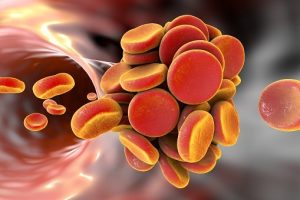 Thrombosis and embolisms are different conditions, but they’re both characterized by a blood clot. Thrombosis happens when a thrombus, or blood clot, forms in a blood vessel. As a result, blood flow through the vessel is reduced. With an embolism, a piece of a blood clot (embolus), foreign object, or other bodily substance becomes lodged in a blood vessel. This largely obstructs blood flow.
Thrombosis and embolisms are different conditions, but they’re both characterized by a blood clot. Thrombosis happens when a thrombus, or blood clot, forms in a blood vessel. As a result, blood flow through the vessel is reduced. With an embolism, a piece of a blood clot (embolus), foreign object, or other bodily substance becomes lodged in a blood vessel. This largely obstructs blood flow.
This clot can travel through the body. Thromboembolism, a similar condition, is when an embolism from a blood clot specifically causes a reduction in blood flow. Many people develop blood clots, and there are many causes of each condition. In cases where blood flow is blocked in a deep vein or large artery, there is a much greater health risk.
Comparison between Thrombosis and Embolism
Advertisement Please kindly disable the ad blocker Thrombosis | Embolism | |
Condition | A blood clot is formed in a blood vessel, obstructing blood flow. The clot, thrombus, does not move to different parts of the body. | A complete or part of a blood clot detaches from its site, causing a blockage in a part of the body. The clot formed is called an embolus and can travel to another part of the body. |
Classification | Thrombosis is classified as venous (formed in a vein) and arterial (formed in an artery) thrombosis. | An embolism is classified as arterial embolism and venous embolism. The first results in a blocked vessel in any part of the body, caused by the moving clot. |
Causes |
|
|
Symptoms | Thrombosis symptoms include the following:
| Embolism symptoms include the following:
|
Complications | There are two main complications of thrombosis and they include pulmonary embolism and post-thrombotic syndrome. Post-thrombotic syndrome is when a patient develops long-term symptoms in their calf including pain, swelling, rashes, and ulcers.p | Complications of embolism include cardiac arrest and sudden death, abnormal heartbeat, shock, pulmonary infarction (death of part of the lung), paradoxical embolism, and pulmonary hypertension. In some cases, a complication may include a buildup of fluid between the outer lining of the lungs and the inner lining of the chest cavity.p |
Differentiating Treatment Methods of Thrombosis and Embolism
Thrombosis Treatment
Treatment of thrombosis depends on the clot’s location. For deep vein thrombosis arterial clots, treatment options include the following:
- Anticoagulants/blood thinners: These medications can be injected or taken orally as pills, and they lower the body’s ability to clot. Although they do not break up existing blood clots, they can prevent them from growing and reduce your risk of developing more. Doctors will inject the drug under the skin over a few days, before prescribing pills to continue thinning the blood. Pill prescriptions may be taken for at least three months, depending on the doctor’s recommendation.
- Clot busters: For serious cases, and if medications are not producing good results, doctors may prescribe drugs that break up the clots. These are known as clot busters, or thrombolytics. They can be administered through an IV line, or a catheter, and can cause serious bleeding if taken incorrectly.
- Filters: If you are unable to take medicines that thin your blood, a filter may be installed into a large vein in your abdomen. This filter in your vena cava can prevent clots that break loose from traveling to your lungs and causing a more serious clot.
- Compression stockings: If the swelling is your major symptom, these stockings can be worn.
Embolism Treatment
Embolism treatment depends on the severity of the condition. Anticoagulants, antiplatelet medications, thrombolytics, and painkillers can be prescribed by doctors. If the flow is blocked completely, doctors may suggest angioplasty, arterial bypass, or embolectomy (clot removed surgically). Some treatments for thrombosis may also be used to treat this condition.
The most important way to prevent a blood clot in your body is to be proactive. Find out if you are at risk and how you can prevent clots from occurring. You can investigate your family history of illnesses, recognize the signs and symptoms, move around if you have been sitting for a long time, maintain a healthy weight, and quit smoking if you do. Learning about the condition and taking care of your health is simple and manageable ways to prevent blood clots and safeguarding your health.
Advertisement
Related:
Asthma patients face higher risk of pulmonary embolism, deep vein thrombosis
Daily meat and eggs may increase blood clot formation
